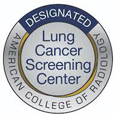Lung Cancer Screening and Results
Lung cancer can be an aggressive disease. It's often hard to spot in its early stage, but advancements are being made in detecting and treating the disease. That's why it’s so important to have regular screenings if you’re at higher risk for developing lung cancer.
Early detection of lung cancer
When you come to AHN Cancer Institute, you benefit from the latest diagnostic and treatment advances in lung cancer. Our comprehensive lung cancer team uses the most sophisticated treatment techniques and technologies to treat your lung cancer and detect it earlier. Your treatment will be specific to your type and stage of lung cancer — personalized for you and your specific diagnosis. We see you at the center of everything.
AHN is accredited by the Screening Center of Excellence and Lung Cancer Screening Center. For you that means you’re getting the most comprehensive care. To earn this accreditation, AHN must operate at the highest level of experience, qualifications, and technical specifications.




Lung cancer risk factors
Since lung cancer doesn't have many symptoms early on in the disease, it's important to know the top lung cancer risk factors.
Smoking
Smoking cigarettes is the leading risk factor for lung cancer and being exposed to secondhand smoke also increases your risk for lung cancer. Any smoke ingested into the lungs can cause health problems and lead to increased risk of disease.
Radon gas
Radon is a radioactive, naturally occurring gas that is emitted from the breakdown of uranium in soil. It is the second-leading cause of lung cancer. It can enter in through cracks in homes or buildings, and when there’s exposure in high concentration, it can cause lung cancer.
Asbestos
Asbestos is a mineral that was once used in many building materials. Breathing in asbestos fibers can cause lung cancer and pleural mesothelioma.
Exposure to pollution and chemicals
Air pollution, especially from diesel exhaust, can increase your risk of lung cancer.
Low-dose computed tomography (LDCT)
What is an LDCT?
A low-dose computed tomography or LDCT is used to screen for lung cancer in people who are at high risk, such as those who smoke, have smoked, or have a history of lung cancer. There is no prep work for a LDCT and it is safe and painless—taking only 15 minutes to complete.
LDCT results
An LDCT or sometimes called a low-dose CT is a lung cancer screening that will provide your care team in-depth, detailed images of any potential issues or problem areas.
Understand your lung cancer screening results
The results from your LDCT will show your doctor if there are lung nodules present. A lung nodule can vary in size, they can be benign or some can be cancerous. Your doctor will be able to review your LDCT results to either monitor the size of a nodule or determine if further evaluation is needed. Depending on your LDCT, you may be assigned a Lung-RADS score.
Lung-RADS Score
Lung-RADS is a lung cancer screening system that uses chest CT to identify people who are at high risk of developing lung cancer. It is based on the size, shape, and location of lung nodules, as well as other factors such as the patient's age, smoking history, and family history of lung cancer.
The Lung-RADS score ranges from 0 to 4. A score of 1 is normal. A score of 2 is benign (not cancer). A score of 3 is likely benign but may require more frequent monitoring. If you have a score of 4, our Comprehensive Multidisciplinary Lung Conference reviews the results for the best next steps.
For more information on treatment, visit our Lung Cancer Condition Page.
Lung cancer screening locations
Ample locations mean ample opportunities to find care that's convenient for you. Visit our locations page to find an imaging location near you.
-
Appointments
Diagnostic Imaging(412) DOCTORS

